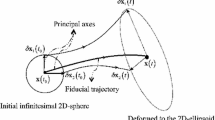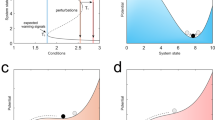Abstract
Transitions from one dynamical regime to another one are observed in many complex systems, especially biological ones. It is possible that even a slight perturbation can cause such a transition. It is clear that this can happen to an object when it is close to a tipping point. There is a lot of interest in finding ways to recognize that a tipping point (in which a bifurcation occurs) is near. There is a possibility that in complex systems, a phenomenon known as “critical slowing down” may be used to detect the vicinity of a tipping point. In this paper, we propose Lyapunov exponents as an indicator of “critical slowing down.”






Similar content being viewed by others
References
Veraart, A.J., Faassen, E.J., Dakos, V., van Nes, E.H., Lürling, M., Scheffer, M.: Recovery rates reflect distance to a tipping point in a living system. Nature 481, 357–359 (2012)
van de Leemput, I.A., Wichers, M., Cramer, A.O., Borsboom, D., Tuerlinckx, F., Kuppens, P., et al.: Critical slowing down as early warning for the onset and termination of depression. Proc. Natl. Acad. Sci. 111, 87–92 (2014)
Dakos, V., Bascompte, J.: Critical slowing down as early warning for the onset of collapse in mutualistic communities. Proc. Natl. Acad. Sci. 111, 17546–17551 (2014)
Scheffer, M., Carpenter, S.R., Lenton, T.M., Bascompte, J., Brock, W., Dakos, V., et al.: Anticipating critical transitions. Science 338, 344–348 (2012)
Dakos, V., Carpenter, S.R., van Nes, E.H., Scheffer, M.: Resilience indicators: prospects and limitations for early warnings of regime shifts. Philos. Trans. R. Soc. B: Biol. Sci. 370, 20130263 (2015)
Christini, D.J., Collins, J.J.: Controlling nonchaotic neuronal noise using chaos control techniques. Phys. Rev. Lett. 75, 2782 (1995)
Sarbadhikari, S., Chakrabarty, K.: Chaos in the brain: a short review alluding to epilepsy, depression, exercise and lateralization. Med. Eng. Phys. 23, 447–457 (2001)
Hadaeghi, F., Hashemi Golpayegani, M.R., Moradi, K.: Does “crisis-induced intermittency” explain bipolar disorder dynamics? Front. Comput. Neurosci. 7, 116 (2013)
Jafari, S., Baghdadi, G., Golpayegani, S., Towhidkhah, F., Gharibzadeh, S.: Is attention deficit hyperactivity disorder a kind of intermittent chaos? J. Neuropsychiatry Clin. Neurosci. 25, E2 (2013)
Mattei, T.A.: Nonlinear (chaotic) dynamics and fractal analysis: new applications to the study of the microvascularity of gliomas. World Neurosurg. 79, 4–7 (2013)
Elbert, T., Ray, W.J., Kowalik, Z.J., Skinner, J.E., Graf, K.E., Birbaumer, N.: Chaos and physiology: deterministic chaos in excitable cell assemblies. Physiol. Rev. 74, 1–47 (1994)
Jafari, S., Ansari, Z., Hashemi Golpayegani, S.M.R., Gharibzadeh, S.: Is attention a “ period window” in the chaotic brain? J. Neuropsychiatry Clin. Neurosci. 25, E05 (2013)
Jafari, S., Baghdadi, G., Hashemi Golpayegani, S.M.R., Towhidkhah, F., Gharibzadeh, S.: Is attention deficit hyperactivity disorder a kind of intermittent chaos? J. Neuropsychiatry Clin. Neurosci. 25, E2 (2013)
Jafari, S., Hashemi Golpayegani, S.M.R., Gharibzadeh, S.: Is there any geometrical information in the nervous system?. Front. Comput. Neurosci. 7 (2013)
Molaie, M., Falahian, R., Gharibzadeh, S., Jafari, S., Sprott, J.C.: Artificial neural networks: powerful tools for modeling chaotic behavior in the nervous system. Front. Comput. Neurosci. 8 (2014)
Falahian, R., Mehdizadeh Dastjerdi, M., Molaie, M., Jafari, S., Gharibzadeh, S.: Artificial neural network-based modeling of brain response to flicker light. Nonlinear Dyn. 81, 1951–1967 (2015)
Kowalik, Z.J., Elbert, T.: Changes of chaoticness in spontaneous EEG/MEG. Integr. Physiol. Behav. Sci. 29, 270–282 (1994)
Kowalik, Z.J., Wróbel, A., Rydz, A.: Why does the human brain need to be a nonlinear system? Behav. Brain Sci. 19, 302–303 (1996)
Mühlnickel, W., Rendtorff, N., Kowalik, Z.J., Rockstroh, B., Miltner, W., Elbert, T.: Testing the determinism of EEG and MEG. Integr. Physiol. Behav. Sci. 29, 262–269 (1994)
Rabinovich, M.I., Varona, P., Selverston, A.I., Abarbanel, H.D.: Dynamical principles in neuroscience. Rev. Mod. Phys. 78, 1213 (2006)
Korn, H., Faure, P.: Is there chaos in the brain? II. Experimental evidence and related models. C. R. Biol. 326, 787–840 (2003)
Gong, Y., Ren, W., Shi, X., Xu, J., Hu, S.: Recovering strange attractors from noisy interspike intervals of neuronal firings. Phys. Lett. A 258, 253–262 (1999)
Elbert, T., Rockstroh, B., Kowalik, Z.J., Hoke, M., Molnar, M., Skinner, J.E., et al.: Chaotic brain activity. Electroencephalogr. Clin. Neurophysiol./Suppl. 44, 441–449 (1995)
Signorini, M.G., Marchetti, F., Cirigioni, A., Cerutti, S.: Nonlinear noise reduction for the analysis of heart rate variability signals in normal and heart transplanted subjects. In: Engineering in Medicine and Biology Society, 1997. Proceedings of the 19th Annual International Conference of the IEEE, pp. 1402–1405 (1997)
Kantz, H., Schreiber, T.: Nonlinear Time Series Analysis, vol. 7. Cambridge University Press, Cambridge (2004)
Patil, D., Hunt, B.R., Kalnay, E., Yorke, J.A., Ott, E.: Local low dimensionality of atmospheric dynamics. Phys. Rev. Lett. 86, 5878 (2001)
Herzel, H., Holzfuss, J., Kowalik, Z., Pompe, B., Reuter, R.: Detecting bifurcations in voice signals. In: Kantz, H., Kurths, J., Meyer-Kress, G. (eds.) Nonlinear Analysis of Physiological Data. pp. 325–344. Springer, Berlin (1998)
d’Humieres, D., Beasley, M., Huberman, B., Libchaber, A.: Chaotic states and routes to chaos in the forced pendulum. Phys. Rev. A 26, 3483 (1982)
Cumming, A., Linsay, P.S.: Quasiperiodicity and chaos in a system with three competing frequencies. Phys. Rev. Lett. 60, 2719 (1988)
Meador, C.-E.E.: Numerical calculation of Lyapunov exponents for three-dimensional systems of ordinary differential equations. Master’s thesis. Marshall University (2011)
Medio, A., Lines, M.: Nonlinear Dynamics: A Primer. Cambridge University Press, Cambridge (2001)
Kowalik, Z., Schnitzler, A., Freund, H.-J., Witte, O.: Local Lyapunov exponents detect epileptic zones in spike-less interictal MEG recordings. Clin. Neurophysiol. 112, 60–67 (2001)
Wolf, A., Swift, J.B., Swinney, H.L., Vastano, J.A.: Determining Lyapunov exponents from a time series. Phys. D: Nonlinear Phenom. 16, 285–317 (1985)
Marhl, M., Perc, M.: Determining the flexibility of regular and chaotic attractors. Chaos Solitons Fractals 28, 822–833 (2006)
Perc, M., Marhl, M.: Sensitivity and flexibility of regular and chaotic calcium oscillations. Biophys. Chem. 104, 509–522 (2003)
Perc, M., Marhl, M.: Local dissipation and coupling properties of cellular oscillators: a case study on calcium oscillations. Bioelectrochemistry 62, 1–10 (2004)
Perc, M., Marhl, M.: Synchronization of regular and chaotic oscillations: the role of local divergence and the slow passage effect–A case study on calcium oscillations. Int. J. Bifurc. Chaos 14, 2735–2751 (2004)
Gosak, M., Stožer, A., Markovič, R., Dolenšek, J., Marhl, M., Rupnik, M.S., et al.: The relationship between node degree and dissipation rate in networks of diffusively coupled oscillators and its significance for pancreatic beta cells. Chaos: Interdiscip. J. Nonlinear Sci. 25, 073115 (2015)
Perc, M., Marhl, M.: Detecting and controlling unstable periodic orbits that are not part of a chaotic attractor. Phys. Rev. E 70, 016204 (2004)
Rosenstein, M.T., Collins, J.J., De Luca, C.J.: A practical method for calculating largest Lyapunov exponents from small data sets. Phys. D: Nonlinear Phenom. 65, 117–134 (1993)
Elert, G.: The chaos hypertextbook. http://hypertextbook.com/chaos (1999)
Fernández Rodríguez, F., Sosvilla Rivero, S., Andrada Félix, J.: A new test for chaotic dynamics using Lyapunov exponents. FEDEA working paper no. 2003–09. https://ssrn.com/abstract=390380 (2003)
Abarbanel, H.D.: Introduction. In: Analysis of Observed Chaotic Data, pp. 1–12. Springer (1996)
Sprott, J.C.: Chaos and Time-Series Analysis, Oxford University Press, Oxford (2003)
Kodba, S., Perc, M., Marhl, M.: Detecting chaos from a time series. Eur. J. Phys. 26, 205 (2004)
Perc, M.: Visualizing the attraction of strange attractors. Eur. J. Phys. 26, 579 (2005)
Perc, M.: Introducing nonlinear time series analysis in undergraduate courses. FIZIKA A-ZAGREB- 15, 91 (2006)
Perc, M.: The dynamics of human gait. Eur. J. Phys. 26, 525 (2005)
Crevier, D.W., Meister, M.: Synchronous period-doubling in flicker vision of salamander and man. J. Neurophysiol. 79, 1869–1878 (1998)
Baghdadi, G., Jafari, S., Sprott, J.C., Towhidkhah, F., Hashemi Golpayegani, S.M.R.: A chaotic model of sustaining attention problem in attention deficit disorder. Commun. Nonlinear Sci. Numer. Simul. 20, 174–185 (2015)
Noy-Meir, I.: Stability in simple grazing models: effects of explicit functions. J. Theor. Biol. 71, 347–380 (1978)
Dakos, V., Carpenter, S.R., Brock, W.A., Ellison, A.M., Guttal, V., Ives, A.R., et al.: Methods for detecting early warnings of critical transitions in time series illustrated using simulated ecological data. PloS ONE 7, e41010 (2012)
Cover, T.M., Thomas, J.A.: Elements of Information Theory. Wiley, New York (2012)
Hilborn, R.C.: Chaos and Nonlinear Dynamics: An introduction for Scientists and Engineers. Oxford University Press on Demand, Oxford (2000)
Acknowledgements
The authors would like to thank Dr. Leslie Samuel Smith for the help and edits.
Author information
Authors and Affiliations
Corresponding author
Rights and permissions
About this article
Cite this article
Nazarimehr, F., Jafari, S., Hashemi Golpayegani, S.M.R. et al. Can Lyapunov exponent predict critical transitions in biological systems?. Nonlinear Dyn 88, 1493–1500 (2017). https://doi.org/10.1007/s11071-016-3325-9
Received:
Accepted:
Published:
Issue Date:
DOI: https://doi.org/10.1007/s11071-016-3325-9




